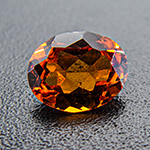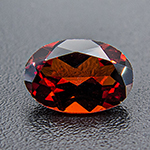Hessonite Garnet
Orange to brownish red variety of grossular garnet, coloured by Fe3+-ions


Origin of name: christened by French mineralogist René-Just Haüy after the Greek word hesson, meaning inferior. This garnet was also called (false) hyazinth and Haüy alluded to its inferior hardness, density and (at the time) value compared to true hyazinth, which is a trade name for orange and red zircon.
Synonyms and trade names: Cinnamon stone, false Hyazinth, Hyazinthoid, all antiquated
Can be confused with: other Garnets and orange or red gem stones like Zircon (Hyazinth), Citrin, Tourmaline etc.
Localities: Hessonite is rather common. Mindat.org lists 25 localities in Austria alone! However, gem quality Hessonite is rare and mostly comes from Sri Lanka. Other localities for gemmy material are in India, Myanmar (Burma), Russia and Canada.
Handling: Hessonite has no cleavage, is quite hard but it is also somewahat brittle. Set with care. hart aber auch etwas spröde. Vorsicht beim Fassen.
Worth knowing: apart from a plethora of rounded Apatite and/or Zircon crystals Hessonite often shows peculiar "treacly" streaks, often described as "heat wave pattern" or "oily".
 Deutsch
Deutsch